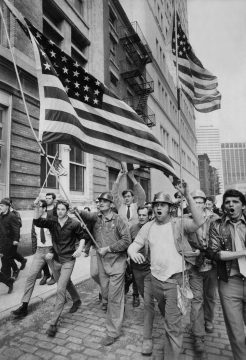Clyde Haberman in The New York Times:
 Kuhn, who has written before about white working-class Americans, builds his book on long-ago police records and witness statements to recreate in painful detail a May day of rage, menace and blood. Antiwar demonstrators had massed at Federal Hall and other Lower Manhattan locations, only to be set upon brutally, and cravenly, by hundreds of steamfitters, ironworkers, plumbers and other laborers from nearby construction sites like the nascent World Trade Center. Many of those men had served in past wars and viscerally despised the protesters as a bunch of pampered, longhaired, draft-dodging, flag-desecrating snotnoses.
Kuhn, who has written before about white working-class Americans, builds his book on long-ago police records and witness statements to recreate in painful detail a May day of rage, menace and blood. Antiwar demonstrators had massed at Federal Hall and other Lower Manhattan locations, only to be set upon brutally, and cravenly, by hundreds of steamfitters, ironworkers, plumbers and other laborers from nearby construction sites like the nascent World Trade Center. Many of those men had served in past wars and viscerally despised the protesters as a bunch of pampered, longhaired, draft-dodging, flag-desecrating snotnoses.
It was a clash of irreconcilable tribes and battle cries: “We don’t want your war” versus “America, love it or leave it.” And it was bewildering to millions of other Americans, including my younger self, newly back home after a two-year Army stretch, most of it in West Germany. My sympathies were with the demonstrators. But I also understood the working stiffs and why they felt held in contempt by the youngsters and popular culture.
New social policies like affirmative action and school busing affected white blue-collar families far more than they did the more privileged classes that spawned many antiwar activists. For Hollywood, the workingman seemed barely a step above a Neanderthal, as in the 1970 movies “Joe,” about a brutish factory worker, and “Five Easy Pieces,” in which a diner waitress is set up to be the target of audience scorn. (Come 1971, we also had “All in the Family” and television’s avatar of working-class bigotry, Archie Bunker.)
It was, too, an era when New York was changing fast and not for the better.
More here.
